11. The major histocompatibility locus codes for many genes of the immune system
24.10 T-cell receptors are related to immunoglobulins |
 |
Figure 24.23 The gd receptor is synthesized early in T-cell development. TCR ab is synthesized later and is responsible for "classical" cell-mediated immunity, in which target antigen and host histocompatibility antigen are recognized together. |
The lymphocyte lineage presents an example of evolutionary opportunism: a similar procedure is used in both B cells and T cells to generate proteins that have a variable region able to provide significant diversity, while constant regions are more limited and account for a small range of effector functions. T cells produce either of two types of T-cell receptor. The different T-cell receptors are synthesized at different times during T-cell development, as summarized in Figure 24.23 (for review see Kronenberg et al., 1986; Marrack and Kappler, 1987)
The γδ receptor is found on <5% of T lymphocytes. It is synthesized only at an early stage of T-cell development. In mice, it is the only receptor detectable at <15 days of gestation, but has virtually been lost by birth at day 20.
TCR αβ is found on >95% of lymphocytes. It is synthesized later in T-cell development than γδ. In mice, it first becomes apparent at 15 V17 days after gestation. By birth it is the predominant receptor. It is synthesized by a separate lineage of cells from those involved in TCR γδ synthesis, and involves independent rearrangement events.
T cells with αβ receptors are divided into several subtypes that have a variety of functions connected with interactions between cells involved in the immune response. Cytotoxic T cells (also known as killer T cells) possess the capacity to lyse an infected target cell. Helper T cells assist T cell-mediated target killing or B cell-mediated antibody-antigen interaction.
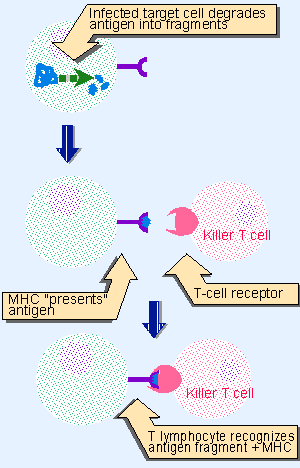 |
Figure 24.2 In cell-mediated immunity, killer T cells use the T-cell receptor to recognize a fragment of the foreign antigen which is presented on the surface of the target cell by the MHC protein. |
The immune response requires a T cell to recognize a host cell displaying a fragment of a foreign protein on its surface. To do so, the T cell simultaneously recognizes the foreign antigen and an MHC protein carried by the presenting cell, as illustrated previously in Figure 24.2. Both helper T cells and killer T cells work in this way, but they have different requirements for the presentation of antigen; different types of MHC protein are used in each case (see later). Helper T cells require antigen to be presented by an MHC class II protein, while killer T cells require antigen to be presented by an MHC class I protein.
The TCR αβ receptor is responsible for helper T cell function in humoral immunity and for killer T cell function in cell-mediated immunity. This places upon it the responsibility of recognizing both the foreign antigen and the host MHC protein. The MHC protein binds a short peptide derived from the foreign antigen, and the TCR then recognizes the peptide in a groove on the surface of the MHC. The MHC is said to present the peptide to the TCR. (The peptide is generated when the proteasome degrades the foreign protein to generate fragments of 8-10 residues long, as described in 8.16 Protein degradation by proteasomes.) A given TCR has specificity for a particular MHC as well as for the foreign antigen. The basis for this dual capacity is one of the most interesting issues to be defined about the αβ TCR.
Like immunoglobulins, a TCR must recognize a foreign antigen of unpredictable structure. A common view has been that Nature might well solve the problem of antigen recognition by B cells and T cells in the same way, in which case we might expect the organization of the T-cell receptor genes to resemble the immunoglobulin genes in the use of variable and constant regions. Each locus is organized in the same way as the immunoglobulin genes, with separate segments that are brought together by a recombination reaction specific to the lymphocyte. The components are the same as those found in the three Ig families.
The organization of the TCR proteins resembles that of the immunoglobulins. The V sequences have the same general internal organization in both Ig and TCR proteins. The TCR C region is related to the constant Ig regions and has a single constant domain followed by transmembrane and cytoplasmic portions. Exon-intron structure is related to protein function.
 |
Figure 24.24 The human TCRa locus has interspersed a and d segments. A Vd segment is located within the Va cluster. The D-J-Cd segments lie between the V gene segments and the J-Ca segments. The mouse locus is similar, but has more Vd segments. |
The resemblance of the organization of TCR genes with the Ig genes is striking. As summarized in Figure 24.24, the organization of TCR α resembles that of Ig κ, with V gene segments separated from a cluster of J segments that precedes a single C gene segment. The organization of the locus is similar in both man and mouse, with some differences only in the number of Vα gene segments and Jα segments. (In addition to the α segments, this locus also contains δ segments, which we discuss shortly (for review see Davis, 1990).
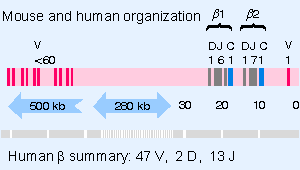 |
Figure 24.25 The TCRb locus contains many V gene segments spread over ~500 kb, and lying ~280 kb upstream of the two D-J-C clusters. |
The components of TCR β resemble those of IgH. Figure 24.25 shows that the organization is different, with V gene segments separated from two clusters each containing a D segment, several J segments, and a C gene segment. Again the only differences between man and mouse are in the numbers of the Vβ and Jβ units.
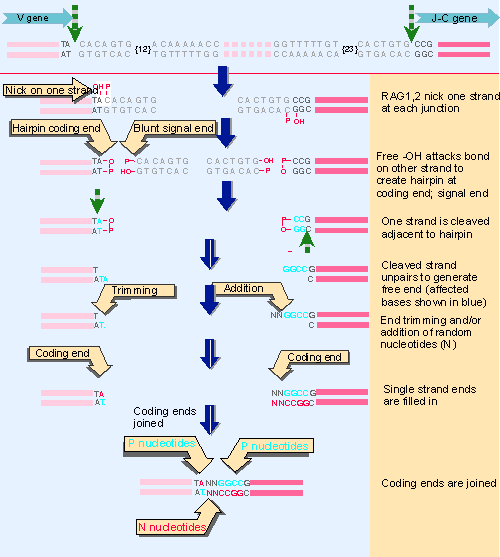 |
Figure 24.14 Processing of coding ends introduces variability at the junction. |
Diversity is generated by the same mechanisms as in immunoglobulins. Intrinsic diversity results from the combination of a variety of V, D, J, and C segments; some additional diversity results from the introduction of new sequences at the junctions between these components (in the form of P and N nucleotides, as described previously in Figure 24.14). Some TCR β chains incorporate two D segments, generated by D-D joins (directed by an appropriate organization of the nonamer and heptamer sequences). A difference between TCR and Ig is that somatic mutation does not occur at the TCR loci. Measurements of the extent of diversity show that the 1012 T cells in man contain 2.5 x 107 different α chains associated with 106 different β chains.
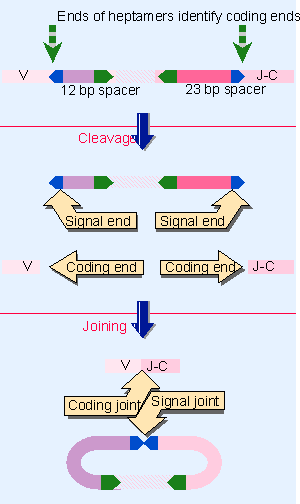 |
Figure 24.13 Breakage and reunion at consensus sequences generates immunoglobulin genes. |
The same mechanisms are likely to be involved in the reactions that recombine Ig genes in B cells and TCR genes in T cells. The recombining TCR segments are surrounded by nonamer and heptamer consensus sequences identical to those used by the Ig genes. This argues strongly that the same enzymes are involved. Most rearrangements probably occur by the deletion model (see Figure 24.13). How is the process controlled so that Ig loci are rearranged in B cells, while T-cell receptors are rearranged in T cells?
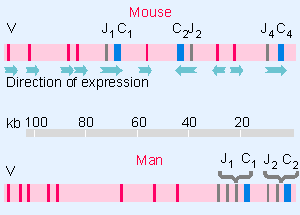 |
Figure 24.26 The TCRg locus contains a small number of functional V gene segments (and also some pseudogenes; not shown), lying upstream of the J-C loci. |
The organization of the γ locus resembles that of Ig λ , with V gene segments separated from a series of J-C segments. Figure 24.26 shows that this locus has relatively little diversity, with ~8 functional V segments. The organization is different in man and mouse. Mouse has 3 functional J-C loci, but some segments are inverted in orientation. Man has multiple J segments for each C gene segment.
The δ subunit is coded by segments that lie at the TCR α locus, as illustrated previously in Figure 24.24. The segments Dδ-Dδ-Jδ-Cδ lie between the V gene segments and the Jα-Cα segments. Both of the D segments may be incorporated into the δ chain to give the structure VDDJ. The nature of the V gene segments used in the δ rearrangement is an interesting question. Very few V sequences are found in active TCR δ chains. In man, only one V gene segment is in general use for δ rearrangement. In mouse, several Vδ segments are found; some are unique for δ rearrangement, but some are also found in α rearrangements. The basis for specificity in choosing V segments in α and δ rearrangement is not known. One possibility is that many of the Vα gene segments can be joined to the DDJδ segment, but that only some (therefore defined as Vδ) can give active proteins (for review see Raulet, 1989).
While for the present we have labeled the V segments that are found in δ chains as Vδ gene segments, we must reserve judgment on whether they are really unique to δ rearrangement. The interspersed arrangement of genes implies that synthesis of the TCR αβ receptor and the γδ receptor is mutually exclusive at any one allele, because the δ locus is lost entirely when the Vα-Jα rearrangement occurs.
Rearrangements at the TCR loci, like those of immunoglobulin genes, may be productive or nonproductive. The β locus shows allelic exclusion in much the same way as immunoglobulin loci; rearrangement is suppressed once a productive allele has been generated. The α locus may be different; several cases of continued rearrangement suggest the possibility that substitution of Vα sequences may continue after a productive allele has been generated.
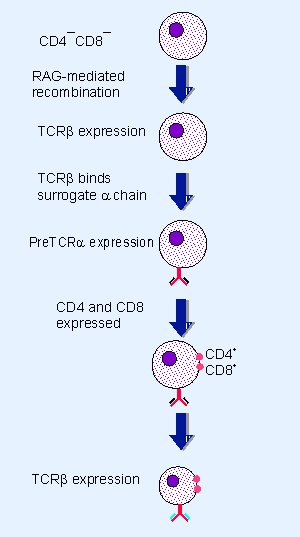 |
Figure 24.27 T cell development proceeds through sequential stages. |
Recombination to generate functional TCR chains is linked to the development of the T lymphocyte, as summarized in Figure 24.27. The first stage is rearrangement to form an active TCR β chain. This binds a nonrearranging surrogate α chain, called preTCRα. At this stage, the lymphocyte has not expressed either of the surface proteins CD4 or CD8. The preTCR heterodimer then binds to the CD3 signaling complex (see below). Signaling from the complex triggers several rounds of cell division, during which α chains are rearranged, and the CD4 and CD8 genes are turned on, so that the lymphocyte is converted from CD4 VCD8 V to CD4+CD8+. This point in development is called β selection. It generates
α chain rearrangement continues in the DP thymocytes. The maturation process continues by both positive selection (for mature TCR complexes able to bind a ligand) and by negative selection (against complexes that interact with inappropriate Xself Xligands). Both types of selection involve interaction with MHC proteins. The DP thymocytes either die after ~3 days or become mature lymphocytes as the result of the selective processes. The surface TCR αβ heterodimer becomes crosslinked on the surface during positive selection (which rescues the thymocytes from cell death), and then, if they survive the subsequent negative selection, allows them to give rise to the separate T lymphocyte classes which are CD4+CD8 V and CD4 VCD8+ (Goldrath and Bevan, 1999).
 |
Figure 24.28 The two chains of the T-cell receptor associate with the polypeptides of the CD3 complex. The variable regions of the TCR are exposed on the cell surface. The cytoplasmic domains of the z chains of CD3 provide the effector function. |
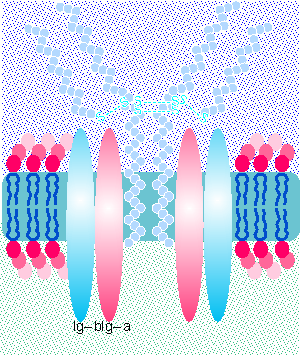 |
Figure 24.22 The B cell antigen receptor consists of an immunoglobulin tetramer (H2L2) linked to two copies of the signal-transducing heterodimer (Igab). |
The T-cell receptor is associated with a complex of proteins called CD3, which is involved in transmitting a signal from the surface of the cell to the interior when its associated receptor is activated by binding antigen. Our present picture of the components of the receptor complex on a T cell is illustrated in Figure 24.28. The important point is that the interaction of the TCR variable regions with antigen causes the ζ subunits of the CD3 complex to activate the T-cell response. The activation of CD3 provides the means by which either αβ or γδ TCR signals that it has recognized an antigen. This is comparable to the constitution of the B cell receptor, in which immunoglobulin associates with the Igαβ signaling chains (see Figure 24.22).
A central dilemma about T-cell function remains to be resolved. Cell-mediated immunity requires two recognition processes. Recognition of the foreign antigen requires the ability to respond to novel structures. Recognition of the MHC protein is of course restricted to one of those coded by the genome, but, even so, there are many different MHC proteins. So considerable diversity is required in both recognition reactions. Although helper and killer T cells rely upon different classes of MHC proteins, they use the same pool of α and β gene segments to assemble their receptors. Even allowing for the introduction of additional variation during the TCR recombination process, it is not clear how enough different versions of the T-cell receptor are made available to accommodate all these demands.
This section updated 1-11-2000
| Reviews | |
| Davis, M. M. (1990). T-cell receptor gene diversity and selection. Ann. Rev. Biochem 59, 475-496. | |
| Goldrath, A. W. and Bevan, M. J. (1999). Selecting and maintaining a diverse T cell repertoire.. Nature 402, 255-262. | |
| Kronenberg, M., Siu, G., Hood, L. E., and Shastri, N. (1986). The molecular genetics of the T-cell antigen receptor and T-cell antigen recognition. Ann. Rev. Immunol. 4, 529-591. | |
| Marrack, P. and Kappler, J. (1987). The T-cell receptor. Science 238, 1073-1079. | |
| Raulet, D. H. (1989). The structure, function, and molecular genetics of the gamma/delta T-cell receptor. Ann. Rev. Immunol. 7, 175-207. | |